Best Silver Watches [Key Factors To Consider]
Note: This page contains affiliate links.
As an Amazon Associate, I earn from qualifying purchases when you click on the link, but you are not charged extra.
Silver watches are more than just timekeeping devices; they are timeless accessories that can elevate any outfit and reflect personal style. With their classic allure and versatile appeal, silver watches have become a staple in the wardrobes of both men and women. Whether you are searching for a sophisticated piece for formal occasions or a casual watch for everyday wear, the right silver watch can seamlessly blend functionality with elegance. This buyer’s guide aims to navigate the myriad of options available in the market, helping you make an informed choice when selecting the perfect silver watch that suits your needs and style preferences.
As you embark on your journey to find the ideal silver watch, it’s essential to consider various factors such as design, craftsmanship, and brand reputation. With a plethora of designs ranging from minimalist styles to intricate, ornate pieces, understanding what to look for can be daunting. This guide will provide insights into key features, tips for maintenance, and how to identify quality craftsmanship, ensuring that your investment is both stylish and durable. Whether you’re a seasoned watch collector or a first-time buyer, this comprehensive guide will equip you with the knowledge to select a silver watch that not only complements your aesthetic but also stands the test of time.
Best Silver Watches: Quick Comparison Table
| Features | Pros | Cons | |
|---|---|---|---|
Luxury Assorted Men’s Watch Set – 4 Pack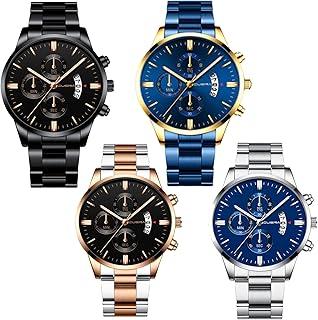 Check Price Check Price |
|
|
|
Luxury Men’s Stainless Steel Dress Watch with Date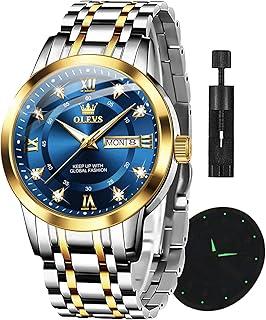 Check Price Check Price |
|
|
|
Luxury Men’s Square Chronograph Watch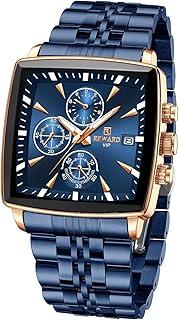 Check Price Check Price |
|
|
|
Men’s Easy-to-Read Stainless Steel Watch with Day/Date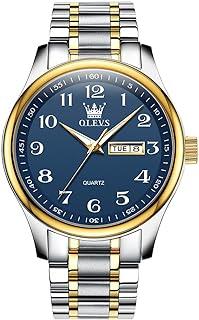 Check Price Check Price |
|
|
|
Men’s Luxury Chronograph Stainless Steel Watch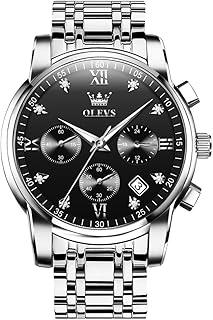 Check Price Check Price |
|
|
|
Men’s Premium Stainless Steel Watch with Rotatable Bezel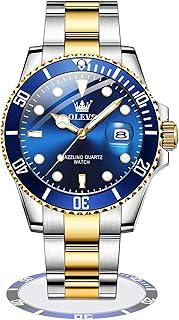 Check Price Check Price |
|
|
|
Men’s Stainless Steel Analog Quartz Watch with Day/Date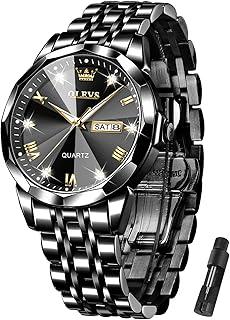 Check Price Check Price |
|
|
|
Luxury Women’s Diamond Analog Watch with Leather Band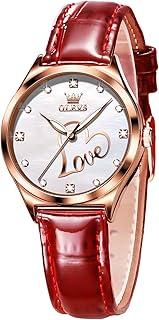 Check Price Check Price |
|
|
|
Women’s Business Dress Stainless Steel Watch with Day/Date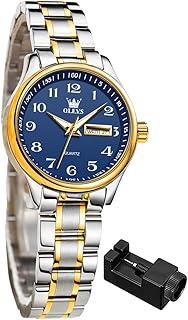 Check Price Check Price |
|
|
|
Luxury Women’s Two-Tone Diamond Dress Watch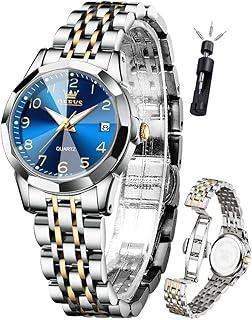 Check Price Check Price |
|
|
|
Recommendations For Best Silver Watches
Luxury Assorted Men’s Watch Set – 4 Pack
This 4-pack set of men’s luxury watches features assorted designs suited for business, casual, and military styles. With stainless steel bands and water-resistant quartz movement, these watches provide durability and reliability. The set includes gold, black, blue, and silver watches, offering variety for different looks and occasions.
Features:
- Quartz movement
- Waterproof design
- Stainless steel band
- Assorted colors (Gold, Black, Blue, Silver)
- Business, casual, and military styles
- Wholesales set
Pros:
- Versatile set for different occasions
- Durable stainless steel bands
- Affordable for a 4-pack
- Water-resistant
Cons:
- No brand recognition
- Limited design variation within the set
Luxury Men’s Stainless Steel Dress Watch with Date
This luxury men’s dress watch features a classic design with stainless steel construction and a convenient date display. Available in white, gold, or blue dials, it offers a sleek look for business and formal settings. The waterproof build ensures durability, making it an excellent choice for daily wear.
Features:
- Stainless steel band
- Waterproof
- Date function
- Classic dress watch
- Gold or silver options
- White, gold, and blue dial choices
Pros:
- Elegant design for formal occasions
- Durable stainless steel
- Water-resistant
- Date display for convenience
Cons:
- Basic features for luxury price
- No chronograph function
Luxury Men’s Square Chronograph Watch
This luxury men’s square face watch offers a bold design with chronograph functionality. Featuring a durable stainless steel band and a luminous display, it’s suitable for both sport and business wear. The waterproof feature and multiple dial color options make it versatile for different occasions.
Features:
- Analog quartz movement
- Square face design
- Chronograph function
- Waterproof
- Luminous hands
- Date display
- Stainless steel band
- Black, silver, blue dial options
Pros:
- Unique square face design
- Chronograph for added functionality
- Water-resistant
- Luminous hands for low-light visibility
Cons:
- Large face may be bulky for some
- Complex dial may be hard to read quickly
Men’s Easy-to-Read Stainless Steel Watch with Day/Date
This casual men’s watch features a large, easy-to-read analog display with day and date functions. The waterproof stainless steel build is enhanced with diamond accents and a combination of Roman and Arabic numerals, giving it a sophisticated yet accessible look.
Features:
- Big face design
- Easy-to-read analog display
- Day and date function
- Waterproof
- Diamond accents
- Roman and Arabic numerals
- Gold, silver, black band options
Pros:
- Large and clear dial
- Day and date display
- Diamond accents for a luxury feel
- Water-resistant for daily use
Cons:
- Bulky design may not suit all tastes
- Limited style versatility
Men’s Luxury Chronograph Stainless Steel Watch
This luxury chronograph watch for men is designed with a bold, big face and easy-to-read display. The stainless steel band, diamond accents, and waterproof build make it both durable and stylish, suitable for formal occasions and daily wear.
Features:
- Chronograph function
- Big face design
- Stainless steel band
- Waterproof
- Date function
- Diamond accents
- Roman and Arabic numerals
- Gold, silver, black tone options
Pros:
- Chronograph for functionality
- Elegant design with diamond details
- Large and easy-to-read display
- Water-resistant for everyday wear
Cons:
- Large size may feel bulky
- Limited casual style options
Men’s Premium Stainless Steel Watch with Rotatable Bezel
This premium men’s watch combines a stainless steel band with a stylish rotatable bezel, giving it a sporty yet sophisticated look. Available in blue, green, and black dials, the watch also features a date display, making it perfect for daily wear or formal occasions.
Features:
- Stainless steel band
- Date function
- Rotatable bezel
- Blue, green, black dial options
- Analog display
Pros:
- Rotatable bezel adds sporty element
- Stylish and classic design
- Durable stainless steel build
- Date function for practicality
Cons:
- No additional complications like chronograph
- Basic features for premium branding
Men’s Stainless Steel Analog Quartz Watch with Day/Date
This men’s stainless steel watch offers a balance of luxury and practicality with its day and date function and diamond accents. The big face design ensures easy readability, while the waterproof feature makes it suitable for everyday wear. Available in various dial colors, it is a versatile option for both casual and formal occasions.
Features:
- Analog quartz movement
- Day and date function
- Diamond accents
- Waterproof
- Big face design
- Blue, black, gold, silver dial options
Pros:
- Day and date display for added convenience
- Stylish diamond details
- Water-resistant for durability
- Large face for easy readability
Cons:
- Bulky design may not suit all wrist sizes
- No chronograph or advanced features
Luxury Women’s Diamond Analog Watch with Leather Band
This luxury women’s watch combines a soft leather band with diamond accents, offering a sophisticated look for formal and everyday wear. The waterproof feature and luminous hands add practicality, while the variety of dial color options makes it easy to match with different outfits.
Features:
- Diamond accents
- Leather band
- Waterproof
- Analog display
- Date function
- Luminous hands
- Green, silver, red dial options
Pros:
- Elegant diamond details
- Comfortable leather band
- Water-resistant for everyday use
- Luminous hands for easy readability in the dark
Cons:
- Leather band may wear out faster than metal
- Limited dial size for those preferring larger watches
Women’s Business Dress Stainless Steel Watch with Day/Date
This women’s business dress watch features a small, elegant design with a stainless steel band, making it perfect for formal occasions. The day and date function adds practicality, while the waterproof build ensures durability for daily use. Available in gold and silver tones, it suits a variety of styles.
Features:
- Analog quartz movement
- Day and date function
- Small face design
- Waterproof
- Stainless steel band
- Gold and silver tone options
Pros:
- Compact and elegant design for small wrists
- Water-resistant
- Stainless steel for durability
- Day and date display for convenience
Cons:
- Limited to smaller wrists
- No advanced features like chronograph
Luxury Women’s Two-Tone Diamond Dress Watch
This luxury women’s dress watch combines a two-tone stainless steel band with diamond accents, providing a refined and sophisticated look. The waterproof design and luminous hands add functionality, making it suitable for both day and night wear. Its small face design is perfect for those with petite wrists.
Features:
- Diamond accents
- Two-tone stainless steel band
- Small face design
- Date function
- Waterproof
- Luminous hands
Pros:
- Elegant two-tone design
- Diamond accents for added luxury
- Water-resistant
- Luminous hands for better visibility
Cons:
- Small face may not appeal to those preferring larger watches
- Limited advanced features
What To Consider When Choosing Silver Watches
When selecting a silver watch, various factors come into play, ranging from the watch’s style and functionality to its materials and brand reputation. Understanding these elements can elevate your choice from a mere purchase to a significant investment that resonates with your personality and lifestyle.
1. Material And Quality
The quality of the silver used in a watch is paramount. Most silver watches are made from either sterling silver or a silver-plated metal. Sterling silver consists of 92.5% pure silver and 7.5% other metals, usually copper, which provides durability and resistance to tarnishing. A genuine sterling silver watch typically carries a hallmark indicating its authenticity, while silver-plated watches are coated with a thin layer of silver over a base metal. While silver-plated options are often more affordable, they may not offer the same longevity and elegance as solid sterling silver.
In addition to silver content, the quality of the watch’s construction is crucial. Look for well-crafted pieces with sturdy clasps, high-quality movements, and attention to detail in the design. Mechanical movements, whether automatic or manual, often signify a higher level of craftsmanship compared to quartz movements, which, while accurate, may lack the artisanal charm of traditional watchmaking.
2. Style And Design
Silver watches come in a variety of styles, each catering to different occasions and personal aesthetics. From elegant dress watches designed for formal events to rugged sports watches suitable for outdoor activities, the design should align with your intended use.
Consider the watch face (or dial) as well. A clean, minimalist dial often complements formal attire, while a more intricate design with sub-dials or complications can enhance a casual look. Additionally, the watch band can significantly impact the overall appearance. Metal bracelets, leather straps, or fabric bands each provide a distinct style, comfort, and functionality. When selecting the watch, ensure the band suits not only your style but also your comfort level—consider how it feels on your wrist and how it balances with your overall outfit.
3. Brand Reputation
The brand behind the watch can greatly influence its quality, resale value, and your overall satisfaction. Renowned watchmakers often have a legacy of craftsmanship and innovation that reflects in their products. Brands like Rolex, Omega, and Tag Heuer are celebrated for their precision engineering and timeless designs, making them ideal choices for those seeking a prestigious silver watch.
However, many lesser-known brands also produce high-quality watches at competitive prices. Researching customer reviews, expert opinions, and brand histories can guide you toward trustworthy options. Consider exploring boutique or independent watchmakers who may offer unique designs and personalized craftsmanship, often with a more approachable price point.
4. Functionality And Features
While aesthetics are important, the functionality of the watch should not be overlooked. Think about what features you need or want from your watch. Some watches come with additional functionalities, such as chronographs, date displays, water resistance, and even smart features like connectivity to your smartphone.
If you’re an active person, a watch with water resistance and a durable build is essential. Conversely, if you prefer a classic look for business meetings or formal occasions, you might opt for a simpler, more elegant design without the extra bells and whistles.
5. Budget Considerations
Budget is always a key factor when purchasing a watch. Silver watches can range from a few hundred to several thousand dollars, depending on the brand, quality, and complexity of the design. It’s essential to determine your budget before diving into the market, as this can narrow down your choices and prevent impulse buys.
Remember, investing in a quality watch can be worthwhile, as it often appreciates over time, especially if it comes from a reputable brand. Consider whether you want a watch for everyday wear or a special occasion, as this will also influence your budget and decision-making process.
Choosing the perfect silver watch is a journey that involves careful consideration of various elements, including material quality, design aesthetics, brand reputation, functionality, and budget. A well-chosen silver watch is not just a tool for telling time; it is a reflection of your personality, an accessory that enhances your style, and potentially a cherished heirloom for future generations.
Take your time to explore different options, try on various styles, and consider how each watch aligns with your lifestyle and personal taste. Whether you opt for a classic, minimalist design or a bold, intricate piece, investing in a quality silver watch can add elegance and sophistication to your wardrobe. Ultimately, the best watch for you is one that resonates with your identity, meets your needs, and makes you feel confident and stylish every time you wear it.
Benefits Of Owning Silver Watches
Owning a silver watch transcends mere timekeeping; it embodies a blend of elegance, sophistication, and practicality. The allure of silver watches lies in their aesthetic appeal and intrinsic properties, making them an exceptional addition to any watch enthusiast’s collection. Here are some of the primary benefits of investing in silver watches:
1. Timeless Elegance
Silver has long been synonymous with luxury and style. Its lustrous sheen complements various outfits, from formal attire to casual wear, making it a versatile choice for any occasion. A silver watch exudes a classic charm that never goes out of fashion, allowing it to remain relevant through changing trends. Unlike some more ostentatious materials, silver offers a refined look that can elevate one’s style without overwhelming it. The understated elegance of silver watches makes them ideal for both professional settings and social gatherings, ensuring that the wearer always looks polished and put together.
2. Durability And Longevity
When crafted with quality and care, silver watches can withstand the test of time. Silver is resistant to corrosion and rust, which means that, with proper maintenance, a silver watch can last for decades, if not generations. Many high-quality silver watches incorporate protective coatings, further enhancing their durability. This longevity makes them an excellent investment, as they can retain or even appreciate in value over time. A well-maintained silver watch can become a cherished heirloom, passed down through families and holding sentimental value along with its monetary worth.
3. Health Benefits
Silver is often lauded for its antibacterial properties, which can have positive implications for watch wearers. Wearing a silver watch may help reduce the risk of skin irritations or infections, particularly for individuals with sensitive skin. The metal can act as a natural antimicrobial agent, inhibiting the growth of bacteria on the surface of the watch. This health benefit makes silver watches not only a stylish accessory but also a practical choice for daily wear.
4. Versatility In Design
Silver watches come in an array of designs, catering to diverse tastes and preferences. Whether one prefers a minimalist design or a more intricate, ornate piece, there is likely a silver watch that fits the bill. Silver’s adaptability allows for the incorporation of various materials, such as leather, gemstones, or ceramics, which can enhance the watch’s aesthetic appeal. This versatility means that silver watches can suit anyone, from the modern professional to the traditionalist, ensuring that every wearer finds a piece that resonates with their personal style.
5. Investment Value
While many might view watches as mere fashion accessories, quality silver watches can also serve as significant investments. The brand, craftsmanship, and rarity of certain models can lead to appreciation in value over time. Limited editions, vintage pieces, and watches from renowned manufacturers can fetch high prices in the collector’s market. Investing in a silver watch can be both a personal delight and a savvy financial decision, particularly if one keeps an eye on market trends and seeks out pieces that exhibit potential for growth in value.
6. Sustainable Choice
In an age where sustainability is paramount, silver watches can be seen as an environmentally friendly option. Silver is a recyclable metal, and many watch manufacturers are increasingly focusing on sustainable practices, using ethically sourced materials and eco-friendly production methods. By choosing a silver watch, consumers can support brands that prioritize environmental responsibility, aligning their purchasing decisions with their values.
Owning a silver watch offers a plethora of benefits that extend far beyond its functional purpose. The timeless elegance of silver, coupled with its durability and health benefits, make it a wise choice for anyone seeking to enhance their accessory collection. With a wide variety of designs available, there is a silver watch to suit every taste and occasion. Moreover, as a valuable investment, a silver watch can appreciate over time, providing not just aesthetic enjoyment but also financial return.
Furthermore, in an era that increasingly values sustainability, opting for a silver watch can reflect a commitment to responsible consumption and environmental stewardship. Whether it serves as a personal statement of style, a functional piece of jewelry, or a treasured heirloom, the benefits of owning a silver watch are manifold, ensuring it remains a cherished accessory for generations to come. Embracing a silver watch is not merely a choice of fashion; it is an investment in artistry, craftsmanship, and enduring elegance.
Features To Look For In The Best Silver Watches
When searching for the perfect silver watch, several features contribute to its quality, durability, and overall aesthetic appeal. A silver watch is not just a timepiece; it is a statement of elegance and style, often signifying luxury and sophistication. Here are the essential features to consider when choosing the best silver watch for your collection:
1. Material Quality
The hallmark of any quality silver watch lies in its material. Stainless steel is the most common base for silver watches, favored for its resistance to rust, corrosion, and tarnishing. The grade of stainless steel is crucial; 316L stainless steel, often referred to as marine grade, is particularly durable and has a higher resistance to scratching and tarnishing than lower grades. For those seeking a more premium feel, consider silver watches made with 925 sterling silver, which contains 92.5% pure silver, resulting in a beautiful, lustrous finish.
2. Craftsmanship And Design
The craftsmanship behind a silver watch can significantly affect its appearance and longevity. Look for details that demonstrate excellent craftsmanship, such as polished surfaces, intricate engravings, and well-finished edges. The design should reflect a balance between style and functionality. Classic designs often feature clean lines, minimalistic dials, and a timeless aesthetic, while contemporary designs may incorporate bold colors and modern shapes. Additionally, the watch should have a coherent design language, with elements like the case, bezel, and strap harmonizing to create a cohesive look.
3. Movement Type
The movement is the heart of a watch, dictating its accuracy and longevity. There are three main types of movements to consider:
-
Quartz Movement: Powered by a battery, quartz watches are known for their precision and low maintenance. They often feature a clean and simple design, making them an excellent choice for everyday wear.
-
Automatic Movement: These watches are self-winding, relying on the natural motion of the wearer’s wrist to keep running. Automatic movements are often favored by enthusiasts for their craftsmanship and intricate mechanisms. They tend to have a more traditional aesthetic and can last for generations with proper care.
-
Manual Movement: Similar to automatic watches but requiring regular winding, manual movements provide a sense of connection between the wearer and the watch. They often feature a vintage design and appeal to purists who appreciate traditional watchmaking techniques.
4. Water Resistance
A quality silver watch should offer adequate water resistance, protecting it from moisture and splashes. Look for watches with a water resistance rating of at least 30 meters (3 ATM) for daily wear, but if you plan to swim or dive, aim for at least 100 meters (10 ATM). This feature not only ensures durability but also extends the watch’s functionality for various occasions.
5. Dial And Display Features
The dial is arguably the most critical aspect of a watch, as it reflects the watch’s character and functionality. Consider the following factors:
-
Legibility: The watch’s hour markers and hands should be easily readable. Look for contrasting colors and luminous materials to enhance visibility in low-light conditions.
-
Complications: These are additional features beyond basic timekeeping, such as date displays, chronographs, or moon phases. Complications add functionality and interest to a watch, showcasing its craftsmanship and complexity.
-
Glass Type: The glass covering the dial can significantly impact durability and aesthetics. Sapphire crystal is the gold standard for premium watches due to its scratch resistance and clarity. Look for watches with anti-reflective coatings for enhanced visibility.
6. Bracelet And Comfort
The bracelet or strap of a silver watch plays a vital role in comfort and style. Silver watches may feature a metal bracelet, leather strap, or even silicone for sportier options. When evaluating a bracelet:
-
Adjustability: Ensure the bracelet has sufficient links or adjustment options to fit comfortably on your wrist. A well-fitting watch is essential for comfort and functionality.
-
Style: The bracelet should complement the watch’s overall design. Metal bracelets offer a classic look, while leather straps can add a touch of sophistication or casual elegance, depending on the color and texture.
7. Brand Reputation And Warranty
Finally, consider the brand’s reputation. Renowned brands are often associated with higher quality and better customer service. Look for reviews, endorsements, and testimonials to gauge the brand’s reliability. Additionally, a solid warranty can provide peace of mind. A reputable watch should come with a warranty of at least two years, covering any manufacturing defects and ensuring long-term satisfaction.
In a world where timepieces are both functional and fashionable, choosing the best silver watch requires careful consideration of various factors. The quality of materials, craftsmanship, movement type, water resistance, dial features, comfort, and brand reputation all contribute to the watch’s overall appeal and functionality. A silver watch is more than just a way to tell time; it is a symbol of style, sophistication, and personal expression.
By selecting a silver watch that encapsulates these essential features, you invest not only in a timeless accessory but also in a piece of art that reflects your individuality. Whether you prefer the classic elegance of a traditional design or the sleek modernity of contemporary aesthetics, a thoughtfully chosen silver watch can enhance your wardrobe, elevate your style, and become a cherished companion for years to come.
How To Choose The Right Size
Choosing the right size for a silver watch is a blend of aesthetics, comfort, and functionality. A well-fitted watch enhances your style while ensuring maximum comfort throughout the day. This guide delves into the factors that influence watch sizing and provides tips for selecting the perfect silver watch for your wrist.
Understanding Watch Size
Case Diameter
The first element to consider is the case diameter, which measures the width of the watch face, excluding the crown. Common sizes for men’s watches range from 38mm to 50mm, while women’s watches typically fall between 26mm and 40mm. However, the trend towards oversized watches has blurred these lines, making it essential to choose a size that complements your wrist.
When assessing case diameter, remember that larger watches can make a bold statement but may be unsuitable for smaller wrists. A watch that’s too big can appear clunky, while one that’s too small may seem delicate or lost. A good rule of thumb is to ensure the case diameter is proportional to your wrist size.
Case Thickness
Case thickness plays a significant role in the overall profile of the watch. Thicker cases often indicate more intricate mechanisms or features, such as chronographs or additional functionalities. However, thick watches can feel bulkier on the wrist, which may lead to discomfort over time.
For a sleek, modern look, consider watches with a thinner profile. This choice not only enhances comfort but also aligns with formal or professional attire. A well-designed silver watch should seamlessly blend into your wrist without overwhelming it.
Band Length And Width
The band of the watch is equally important in determining the right fit. Silver watches typically come with either metal link bracelets or leather straps. The length of the band should allow the watch to sit comfortably on your wrist, not too tightly but also not so loose that it slides around.
To find the right band length, measure your wrist circumference and compare it to the watch’s band specifications. Additionally, the width of the band should be in proportion to the case diameter. A wider band may complement a larger watch face, while a thinner band can enhance the elegance of a smaller watch.
Watch Style And Design
The style of the watch can also influence your choice in size. For instance, a dress watch is often designed to be more understated, with a slimmer profile, while a sports watch may be bulkier and more robust. Consider the occasions on which you plan to wear the watch; if it’s for daily use, you might prefer something versatile yet stylish, while for formal events, a more refined piece could be appropriate.
Trying It On
The best way to ensure you’ve chosen the right size is to try the watch on. Visit a store where you can physically wear the silver watch and observe how it feels. Pay attention to how the watch sits on your wrist. It should not pinch or dig into your skin, and you should be able to slide a finger comfortably between the band and your wrist.
While trying on, take note of how the watch looks in different lighting conditions, as silver can reflect light in unique ways. It can enhance or diminish the watch’s appeal depending on the size, shape, and design of the timepiece.
Adjusting The Fit
If you choose a watch with a metal bracelet, most can be adjusted by removing or adding links to achieve a perfect fit. Some brands offer professional adjustments, ensuring that your watch sits comfortably on your wrist. For leather straps, consider options that allow for fine adjustments or have multiple holes to secure the watch snugly.
Choosing the right size for a silver watch is an art that combines understanding personal style, physical comfort, and functionality. Whether you prefer a classic timepiece with a slim profile or a bold watch with a larger case, knowing the essential sizing factors will empower you to make an informed decision. Always remember that a watch is not just a tool for keeping time; it’s an accessory that can express your individuality and complement your style. By considering the case diameter, thickness, band length, and personal fit preferences, you can select a silver watch that enhances your wardrobe and reflects your personality. Ultimately, the perfect silver watch will be one that fits seamlessly into your lifestyle, making you feel confident and stylish every time you check the time.
Durability And Performance
Silver watches, renowned for their elegance and timeless appeal, have captured the hearts of watch enthusiasts for centuries. But beyond their aesthetic charm lies a realm of durability and performance that merits attention. In this section, we will delve into the characteristics of silver watches, examining the materials, craftsmanship, and performance metrics that define them.
The Allure Of Silver
Silver, known for its lustrous finish and reflective quality, has been a symbol of sophistication and wealth throughout history. Unlike gold or platinum, silver presents a unique blend of affordability and luxury, making it a popular choice among both high-end and everyday watchmakers. Its malleability allows artisans to craft intricate designs and detailed engravings, adding to the watch’s unique character. However, while silver’s beauty is undeniable, it raises questions about durability.
Understanding Silver Alloys
Most silver watches are made from sterling silver, an alloy that comprises 92.5% silver and 7.5% other metals, typically copper. This composition enhances the overall strength of the material, making it more suitable for watch cases and bracelets. The incorporation of copper not only increases the durability but also helps prevent tarnishing, a common issue with pure silver.
Sterling silver retains its natural beauty while offering improved resistance to scratches and dents. However, it’s essential to acknowledge that silver can still tarnish over time, especially when exposed to air and moisture. To combat this, many manufacturers apply protective coatings or finishes that help preserve the silver’s sheen while minimizing maintenance needs.
Craftsmanship And Design
The craftsmanship involved in creating silver watches is a significant factor in their durability and performance. High-quality silver watches often feature robust movements, meticulously assembled by skilled watchmakers. These movements can range from mechanical to quartz, each offering different benefits.
-
Mechanical Movements: These movements are celebrated for their artistry and precision. They rely on intricate gears and springs, meticulously crafted and assembled, to keep time. While mechanical movements are often regarded as less durable than quartz due to their susceptibility to shocks and environmental changes, many high-end brands enhance durability through innovations like shock resistance and anti-magnetic components.
-
Quartz Movements: Renowned for their accuracy and low maintenance, quartz movements utilize a battery to power the watch. They are less susceptible to physical shocks, making them a durable choice for daily wear. In addition, quartz watches often come equipped with features such as water resistance, enhancing their overall performance in various environments.
Performance Features
When considering the performance of silver watches, several key features come into play:
-
Water Resistance: Many silver watches incorporate water-resistant designs, allowing wearers to enjoy activities like swimming or diving without fear of damage. Water resistance ratings are crucial, with watches designed for depths of 30 meters being suitable for everyday use, while those rated at 100 meters or more can withstand water pressure during aquatic activities.
-
Scratch Resistance: The durability of a watch is often measured by its ability to resist scratches. While silver itself is softer than materials like stainless steel or sapphire crystal, many manufacturers equip silver watches with protective coatings or incorporate scratch-resistant materials in their design.
-
Longevity of Movement: The heart of a watch—the movement—plays a crucial role in its overall performance. High-quality movements, whether mechanical or quartz, are engineered for longevity. Brands often provide warranties that can last several years, assuring consumers of the reliability of their timepieces.
-
Maintenance: To ensure optimal performance, regular maintenance is essential. This may include cleaning the watch, checking for water resistance, and servicing the movement. A well-maintained silver watch can last for generations, transcending trends and retaining its appeal.
The Appeal Of Vintage Silver Watches
Vintage silver watches are a niche market that combines the charm of historical craftsmanship with modern durability considerations. Collectors often seek out timepieces that tell a story—watches that have endured the test of time and showcase the evolution of design and technology. While vintage watches may require more care and attention due to their age, they often possess unique features and artistry that make them desirable to aficionados.
Silver watches represent a harmonious blend of beauty, durability, and performance. Their unique alloy composition, meticulous craftsmanship, and thoughtful design features make them a reliable choice for both casual and formal occasions. While the allure of silver is undeniable, its ability to withstand the rigors of daily wear is equally impressive, provided that proper care and maintenance are observed.
As we embrace modern technology and innovative materials in the world of horology, silver watches remain a testament to the artistry and tradition of watchmaking. Whether worn for their aesthetic appeal, precision, or historical significance, silver watches continue to captivate the hearts of enthusiasts and casual wearers alike. Their timeless nature ensures they will remain relevant, transcending fleeting fashion trends, and enduring as symbols of sophistication and craftsmanship for years to come.
How To Care For Your Silver Watches
1. Regular Cleaning
Silver watches are renowned for their lustrous shine, but they can tarnish over time due to exposure to air, moisture, and chemicals. Regular cleaning is vital to maintaining their brilliance.
- Soft Cloth Wipe: Use a soft, lint-free cloth to gently wipe your watch after each wear. This helps remove oils, dirt, and moisture that can accumulate on the surface.
- Soap and Water: For a deeper clean, you can wash your silver watch with warm, soapy water. Mix a few drops of mild dish soap in a bowl of warm water. Soak a soft cloth in the solution and wring it out before gently wiping the watch. Avoid submerging the watch, especially if it has a leather strap or any non-water-resistant components.
- Silver Polish: If your watch shows signs of tarnishing, consider using a silver polish specifically designed for jewelry. Apply a small amount to a soft cloth and gently buff the tarnished areas. Always follow the manufacturer’s instructions to avoid damaging the watch’s finish.
2. Storage
Proper storage plays a critical role in the longevity of your silver watch. The way you store your watch can protect it from environmental factors that could lead to tarnishing or scratches.
- Watch Box or Pouch: Store your silver watch in a dedicated watch box or a soft pouch to protect it from dust and scratches. Avoid placing it on hard surfaces or in areas where it may come into contact with other jewelry.
- Humidity Control: Silver can tarnish more rapidly in humid environments. If you live in a humid climate, consider using silica gel packets in your storage box to absorb excess moisture.
- Avoid Direct Sunlight: Store your watch in a cool, dark place away from direct sunlight, as UV rays can cause fading and deterioration of the materials used in the watch.
3. Avoid Harsh Chemicals
Exposure to certain chemicals can cause damage to both the silver and any other materials used in your watch, such as leather or synthetic straps.
- Perfumes and Lotions: Always apply perfumes, lotions, and other cosmetics before putting on your watch. These products can contain harsh chemicals that may tarnish silver.
- Household Cleaners: Be cautious around household cleaners and chemicals. When cleaning around your home, remove your watch to prevent accidental exposure to harmful substances.
- Swimming and Bathing: Avoid wearing your silver watch while swimming, showering, or engaging in any activity where it might be submerged in water or exposed to harsh chemicals, such as chlorine.
4. Periodic Professional Maintenance
While regular cleaning can help keep your silver watch in good condition, periodic professional maintenance can ensure its long-term health.
- Service Schedule: Consider having your watch serviced every few years by a professional watchmaker. They can clean internal components, replace batteries, and check for any signs of wear or damage.
- Water Resistance Check: If your watch is water-resistant, it’s essential to have its seals checked periodically to ensure they remain intact. This is especially important if you wear your watch in wet conditions.
5. Mindful Wearing
How you wear your watch can significantly impact its condition. Being mindful about your activities while wearing your watch can help prevent damage.
- Avoid Impact: Be cautious during activities that could expose your watch to hard surfaces or sudden impacts. Remove your watch during high-impact sports or activities to avoid scratches or dents.
- Fit Adjustment: Ensure your watch fits correctly. A watch that is too loose can move around your wrist, increasing the risk of scratching, while one that is too tight can cause discomfort and potentially damage the watch’s internal components.
6. Know Your Watch’s Specifics
Different watches have unique materials and designs, which can require specific care practices.
- Material Considerations: Understand the materials used in your silver watch. If it features additional components such as gemstones, leather, or enamel, ensure you know how to care for these specific materials.
- Manufacturer Instructions: Always refer to the manufacturer’s care instructions. They may provide valuable insights into the best practices for maintaining your watch’s specific design and materials.
Caring for your silver watch is a commitment that pays off in terms of both aesthetics and functionality. By incorporating regular cleaning into your routine, storing your watch properly, avoiding harsh chemicals, and seeking periodic professional maintenance, you can preserve its beauty and extend its lifespan. Additionally, being mindful of how you wear your watch—ensuring that it fits well and is protected during various activities—further contributes to its longevity.
Ultimately, your silver watch is not just a timekeeping device; it is an expression of style, elegance, and craftsmanship. With the right care, it can remain a cherished accessory for years to come, maintaining its timeless appeal and functionality. Whether you wear it daily or reserve it for special occasions, investing the time and effort in proper care will ensure that your silver watch remains a gleaming testament to your taste and appreciation for fine craftsmanship.
Comparing Silver Watches With Alternatives
Silver watches, with their classic allure and versatility, have long been a staple in the world of horology. However, as consumers explore various options, they often find themselves weighing silver watches against an array of alternatives, each boasting unique attributes. To make an informed choice, it’s essential to consider not only the aesthetics and material but also the practicality and longevity of these timepieces.
The Allure Of Silver
Silver watches are often lauded for their timeless elegance and refined aesthetic. The lustrous sheen of silver, whether in sterling or solid form, radiates sophistication and can effortlessly complement a range of outfits, from casual to formal. Unlike some materials that can appear overly flashy or gaudy, silver strikes a balance, enhancing the wearer’s appearance without overwhelming it.
When compared to gold, silver presents a more understated option that appeals to individuals seeking a less ostentatious piece. Gold watches, while undeniably luxurious, can sometimes convey a sense of extravagance that does not suit every occasion or personal style. Furthermore, silver is generally more affordable than gold, making it a practical choice for those who desire quality without breaking the bank.
Durability: Silver Vs. Other Metals
While silver is prized for its beauty, it is crucial to discuss its durability. Silver watches, particularly those made of sterling silver, are softer than their gold and stainless steel counterparts. This softness makes silver more prone to scratches and dents over time, necessitating regular maintenance to keep the timepiece looking pristine. In contrast, stainless steel watches are known for their exceptional durability and resistance to scratches. They are often coated with protective finishes, enhancing their longevity even further.
Moreover, titanium watches have emerged as a popular alternative, known for their lightweight feel and remarkable strength. Titanium is resistant to corrosion and scratches, making it an ideal choice for active individuals or those seeking a watch that can withstand the rigors of daily wear. While titanium lacks the traditional elegance of silver, it appeals to those prioritizing functionality and durability.
Aesthetic Appeal: Silver Vs. Alternatives
In the realm of aesthetics, silver watches often take center stage due to their versatility in design. They can seamlessly transition between classic and contemporary styles, adorned with intricate embellishments or left minimalist for a sleek look. The reflective quality of silver allows it to harmonize beautifully with various dial colors and materials, enhancing the overall appearance of the watch.
On the other hand, alternative materials like ceramic and resin have gained traction for their unique textures and innovative designs. Ceramic watches, for instance, are celebrated for their scratch resistance and lightweight feel, making them suitable for everyday wear. They come in various colors, allowing wearers to express their personalities through vibrant hues. However, the lack of the timeless appeal found in silver may deter traditionalists.
Functionality And Purpose
When considering silver watches, it’s essential to evaluate the intended purpose of the timepiece. For those seeking a classic dress watch, silver remains an unparalleled choice. Its elegant appearance pairs flawlessly with formal attire, making it an excellent accessory for weddings, galas, and other special occasions.
Conversely, if one requires a watch for outdoor adventures or sports, a stainless steel or titanium option may be more suitable. These materials can withstand harsh conditions and are often equipped with features such as water resistance and durability that silver simply cannot offer. Smartwatches, which have surged in popularity, present an entirely different alternative, providing functionality that surpasses traditional watches. They offer a range of features, from fitness tracking to notifications, appealing to a tech-savvy audience.
In the quest for the perfect timepiece, comparing silver watches with alternatives reveals a diverse landscape of options, each with its distinct advantages and drawbacks. Silver watches, with their timeless elegance and versatility, remain a classic choice for those seeking a sophisticated accessory. However, factors such as durability, functionality, and personal style play pivotal roles in guiding consumers toward their ultimate decision. While silver shines in formal settings and provides an aesthetic that transcends trends, alternatives like stainless steel, titanium, ceramic, and smartwatches cater to various lifestyles and preferences. Ultimately, the choice between silver and its alternatives hinges on individual priorities—whether one values timeless beauty, rugged durability, or cutting-edge technology. Each type of watch tells its own story, making the selection process as much about personal expression as it is about practicality. In this light, the journey to finding the perfect watch becomes not just a search for a timekeeper but a reflection of one's identity and values.
Style And Design Trends For Silver Watches
Silver watches have long been celebrated for their elegance, versatility, and timeless appeal. As fashion evolves, so too do the trends surrounding silver timepieces, incorporating elements of modern design, technological advancements, and individual expression. This section delves into the current style and design trends that are shaping the landscape of silver watches, exploring various aesthetics, materials, and functions that appeal to today’s discerning watch enthusiasts.
1. Minimalist Aesthetics
One of the most pronounced trends in silver watch design is the minimalist aesthetic. Stripped of unnecessary embellishments, minimalist watches prioritize clean lines and simple dials, allowing the intrinsic beauty of silver to shine. These timepieces often feature a monochromatic color palette, utilizing shades of gray, white, and black to create a cohesive look. Brands like Daniel Wellington and MVMT have popularized this trend, producing watches that embody understated elegance, making them perfect for both casual and formal settings. The trend also emphasizes functionality, with many minimalist watches focusing on essential features, often omitting complications that can clutter the dial.
2. Mixed Materials
Modern silver watches frequently incorporate mixed materials to create unique, eye-catching designs. The fusion of silver with other metals, such as gold or rose gold, enhances visual interest and adds layers of complexity to the timepiece. For example, a silver watch with gold accents on the bezel or hour markers can create a luxurious appearance without being overly ostentatious. Additionally, the use of materials like ceramic, leather, or rubber straps complements the silver case, providing both comfort and versatility. This blending of materials caters to diverse tastes, allowing wearers to express their individuality through their choice of timepieces.
3. Bold Dial Designs
In recent years, there has been a shift towards more adventurous dial designs, transforming silver watches into bold fashion statements. Dials with intricate patterns, textured surfaces, or vibrant colors offer a striking contrast to the sleek silver casing, drawing attention to the watch as a centerpiece of any outfit. Brands such as Seiko and Omega have embraced this trend, incorporating unique features like sunburst patterns, gradient colors, and even artistic engravings. This trend not only enhances the visual appeal but also encourages wearers to choose watches that reflect their personality and style preferences.
4. Sustainability And Ethical Sourcing
As awareness of environmental issues grows, consumers are increasingly drawn to silver watches that prioritize sustainability and ethical sourcing. Many brands are now committing to using recycled materials or responsibly sourced silver in their manufacturing processes. This trend is particularly appealing to younger generations who value transparency and corporate responsibility. Moreover, watchmakers are focusing on longevity, producing timepieces designed to withstand the test of time both in terms of style and durability. The concept of “buying less, but buying better” resonates strongly in this context, as consumers seek quality over quantity in their purchases.
5. Smart Features And Technology Integration
The integration of technology into traditional silver watches has given rise to a new category of timepieces: smartwatches. While smartwatches have traditionally been made from plastic or silicone, many brands are now offering models that incorporate silver in their design, elevating the aesthetic while maintaining functionality. These hybrid models feature touchscreens and advanced capabilities, such as fitness tracking, notifications, and customizable watch faces, all while preserving the elegance of silver. Brands like Garmin and Apple have successfully merged the sleek look of silver with cutting-edge technology, appealing to tech-savvy consumers who desire both style and functionality.
Conclusion
In the dynamic world of horology, silver watches continue to evolve, reflecting broader societal trends and consumer preferences. The current style and design trends highlight a shift towards minimalism, mixed materials, bold dials, sustainability, and technological integration. As wearers increasingly seek pieces that resonate with their personal values and lifestyles, silver watches have emerged as versatile, stylish, and timeless accessories that effortlessly complement a myriad of occasions.
The beauty of silver watches lies not only in their aesthetic appeal but also in their ability to blend tradition with innovation. Whether one opts for a minimalist design, a bold statement piece, or a technologically advanced smartwatch, the options are endless. Ultimately, silver watches represent a harmonious union of craftsmanship and creativity, embodying a style that is both classic and contemporary, ensuring their place in the wardrobes of watch enthusiasts for years to come.
FAQs
What Materials Are Commonly Used In Silver Watches?
Silver watches are typically made from various types of silver, including sterling silver (92.5% silver and 7.5% other metals, usually copper), and stainless steel with a silver finish. Some watches may also incorporate silver plating or a silver-colored alloy for aesthetic purposes.
How Do I Properly Care For And Maintain My Silver Watch?
To maintain your silver watch, regularly clean it with a soft, lint-free cloth to remove dirt and oils. For deeper cleaning, use a solution of mild soap and warm water, applying it gently with a soft brush. Avoid exposing your watch to harsh chemicals and store it in a dry, cool place. Regularly check for any signs of wear, especially on the clasp and strap.
Can Silver Watches Be Water-resistant?
Yes, many silver watches are designed to be water-resistant, but the level of resistance can vary. Always check the manufacturer’s specifications for water resistance ratings, typically measured in meters or ATM (atmospheres). It’s important to note that water resistance does not mean waterproof, so it’s advisable to avoid submerging any watch that is not explicitly rated for such use.
What Are The Advantages Of Silver Watches Over Other Materials?
Silver watches offer a unique blend of elegance and durability. They are often lighter than stainless steel watches, providing comfort for daily wear. Additionally, silver has a classic, timeless aesthetic that pairs well with various styles, making it a versatile choice. Silver also has natural antimicrobial properties, which can be an added benefit for some wearers.
How Can I Tell If My Silver Watch Is Genuine?
To verify the authenticity of a silver watch, look for hallmarks or stamps indicating the silver content, such as ‘925’ for sterling silver. Additionally, check the manufacturer’s branding, weight, and overall craftsmanship. If in doubt, consult a professional jeweler or watch expert for appraisal and verification.
What Styles Of Silver Watches Are Available?
Silver watches come in various styles, including analog, digital, and hybrid models. Common designs range from classic dress watches to sporty chronographs and casual everyday wear. There are also fashion watches with unique embellishments and features, allowing for personalization to suit different tastes.
Are Silver Watches Suitable For Everyday Wear?
Yes, many silver watches are designed for everyday wear, providing a balance of style and functionality. However, factors like the watch’s design, materials, and water resistance should be considered. For active lifestyles, look for watches specifically marketed as robust or durable.
What Are Some Popular Brands That Offer Silver Watches?
Popular brands that offer silver watches include Seiko, Citizen, Tissot, TAG Heuer, and Fossil. Luxury brands like Rolex and Omega also have stunning silver options. Each brand offers a range of styles and price points, catering to various preferences and budgets.
How Does The Price Of Silver Watches Compare To Other Types?
The price of silver watches can vary widely based on brand, craftsmanship, and features. Generally, silver watches tend to be more affordable than luxury watches made from precious metals like gold or platinum. However, high-end silver watches from reputable brands can still reach premium prices due to their quality and craftsmanship.
Can I Wear My Silver Watch With Any Outfit?
Silver watches are highly versatile and can be worn with a variety of outfits, from formal attire to casual wear. Their neutral color complements both warm and cool tones, making them an excellent accessory for almost any look. To enhance your outfit, consider the watch’s design-sleeker designs are better suited for formal occasions, while more robust styles work well for casual settings.
